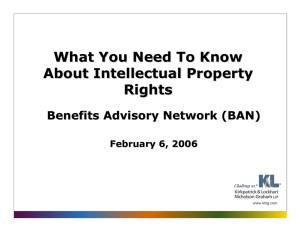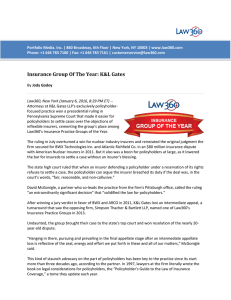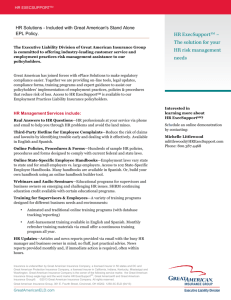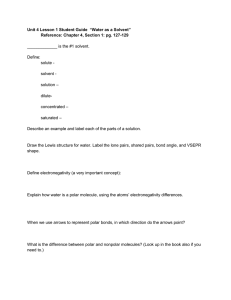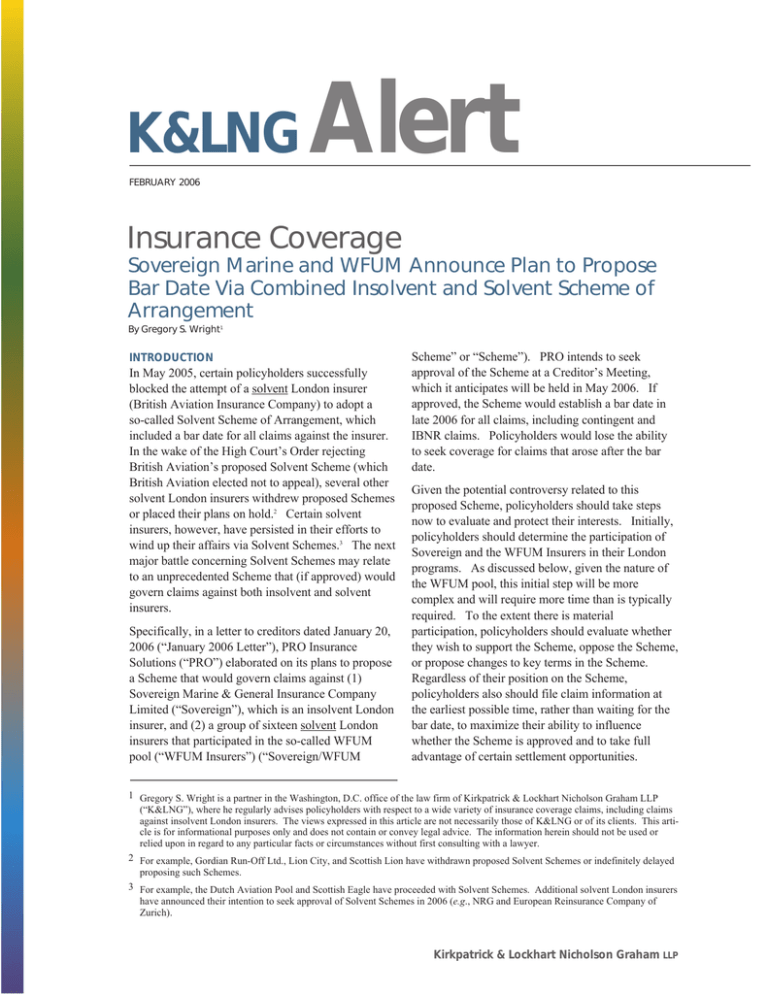
K&LNG
Alert
FEBRUARY 2006
Insurance Coverage
Sovereign Marine and WFUM Announce Plan to Propose
Bar Date Via Combined Insolvent and Solvent Scheme of
Arrangement
By Gregory S. Wright1
INTRODUCTION
In May 2005, certain policyholders successfully
blocked the attempt of a solvent London insurer
(British Aviation Insurance Company) to adopt a
so-called Solvent Scheme of Arrangement, which
included a bar date for all claims against the insurer.
In the wake of the High Court’s Order rejecting
British Aviation’s proposed Solvent Scheme (which
British Aviation elected not to appeal), several other
solvent London insurers withdrew proposed Schemes
or placed their plans on hold.2 Certain solvent
insurers, however, have persisted in their efforts to
wind up their affairs via Solvent Schemes.3 The next
major battle concerning Solvent Schemes may relate
to an unprecedented Scheme that (if approved) would
govern claims against both insolvent and solvent
insurers.
Specifically, in a letter to creditors dated January 20,
2006 (“January 2006 Letter”), PRO Insurance
Solutions (“PRO”) elaborated on its plans to propose
a Scheme that would govern claims against (1)
Sovereign Marine & General Insurance Company
Limited (“Sovereign”), which is an insolvent London
insurer, and (2) a group of sixteen solvent London
insurers that participated in the so-called WFUM
pool (“WFUM Insurers”) (“Sovereign/WFUM
Scheme” or “Scheme”). PRO intends to seek
approval of the Scheme at a Creditor’s Meeting,
which it anticipates will be held in May 2006. If
approved, the Scheme would establish a bar date in
late 2006 for all claims, including contingent and
IBNR claims. Policyholders would lose the ability
to seek coverage for claims that arose after the bar
date.
Given the potential controversy related to this
proposed Scheme, policyholders should take steps
now to evaluate and protect their interests. Initially,
policyholders should determine the participation of
Sovereign and the WFUM Insurers in their London
programs. As discussed below, given the nature of
the WFUM pool, this initial step will be more
complex and will require more time than is typically
required. To the extent there is material
participation, policyholders should evaluate whether
they wish to support the Scheme, oppose the Scheme,
or propose changes to key terms in the Scheme.
Regardless of their position on the Scheme,
policyholders also should file claim information at
the earliest possible time, rather than waiting for the
bar date, to maximize their ability to influence
whether the Scheme is approved and to take full
advantage of certain settlement opportunities.
1 Gregory S. Wright is a partner in the Washington, D.C. office of the law firm of Kirkpatrick & Lockhart Nicholson Graham LLP
(“K&LNG”), where he regularly advises policyholders with respect to a wide variety of insurance coverage claims, including claims
against insolvent London insurers. The views expressed in this article are not necessarily those of K&LNG or of its clients. This article is for informational purposes only and does not contain or convey legal advice. The information herein should not be used or
relied upon in regard to any particular facts or circumstances without first consulting with a lawyer.
2 For example, Gordian Run-Off Ltd., Lion City, and Scottish Lion have withdrawn proposed Solvent Schemes or indefinitely delayed
proposing such Schemes.
3 For example, the Dutch Aviation Pool and Scottish Eagle have proceeded with Solvent Schemes. Additional solvent London insurers
have announced their intention to seek approval of Solvent Schemes in 2006 (e.g., NRG and European Reinsurance Company of
Zurich).
Kirkpatrick & Lockhart Nicholson Graham LLP
THE PROPOSED SCHEME
In its January 2006 Letter, PRO – the WFUM pool
run-off manager and proposed Scheme Manager –
discusses the proposed Sovereign/WFUM Scheme.
Sovereign is an insolvent insurer that has been
operating under a so-called “reserving” Scheme of
Arrangement for many years. The proposal at issue
would convert Sovereign’s existing Scheme to a socalled “closing” Scheme, which imposes a bar date
and requires the Scheme Administrator to estimate
the value of contingent and IBNR claims. In recent
years, several other insolvent London insurers (e.g.,
KWELM, Andrew Weir, etc.) have secured creditor
approval to amend their Schemes to impose bar
dates, in lieu of continuing in liquidation for decades.
The proposed Sovereign/WFUM Scheme, however,
seeks not only to convert the existing Sovereign
Scheme, but also to add the solvent WFUM insurers.4
This attempt to combine solvent and insolvent
insurers in one Scheme is unprecedented. PRO has
argued that the “collective” scheme is justified
because Sovereign and the WFUM Insurers share
common reinsurance claims. Specifically, PRO has
stated that “given the fragmentation of the WFUM
pool which would occur if Sovereign and its solvent
subsidiaries were to close in isolation, and the
associated complexity for policyholders, one of the
aims of the Pool Scheme is to enable the closure of
the pool business to be carried out for the Scheme
Companies and their policyholders in a unified and
efficient manner.”5
Procedurally, Sovereign and the WFUM Insurers are
seeking to schedule a hearing with the High Court of
Justice in London to seek permission to propose the
Scheme to their creditors. The hearing will be held
“no earlier than 21 February 2006.”6 According to
PRO, as of February 10, 2006, the court hearing has
not been scheduled. Assuming the High Court
grants permission, PRO intends to schedule the
Creditors’ Meeting to vote on the proposed
Sovereign/WFUM Scheme in May 2006.
Given that the proposed Scheme relates to a “pool”
of insurers, it raises various logistical issues. To
illustrate, PRO’s January 2006 Letter identifies
sixteen (16) Scheme Companies, but states that “the
above are the current names of the WFUM pool
participants and as such are not necessarily the names
that were in existence at the time that the business
was written.” PRO’s January 2006 Letter then refers
creditors to the WFUM web site
(www.wfumpools.com), which identifies dozens of
additional insurers (e.g., former names or predecessor
companies) that are potentially impacted by the
Scheme. To complicate matters, though, the Scheme
appears to impact the identified insurers only to the
extent that they participated in one of the hundreds of
“stamps” identified in a 120-page PDF.file linked to
the web site.
Given the complex nature of the pool, policyholders
should allow for sufficient time to determine the
relevant participation of the Scheme Companies. As
a starting point, policyholders should request from
PRO their unique login identification and password,
which will permit policyholders or their counsel to
access a web site containing participation information
prepared by PRO. In many cases in the past,
however, participation information posted by insurers
on web sites has been inaccurate or incomplete. As
such, policyholders should also review their own
policies to confirm the relevant participation.
ISSUES RELATED TO SOLVENT SCHEMES
As noted above, Solvent Schemes have generated
considerable controversy in the policyholder
community in recent years. Since the early 1990s,
insolvent London insurers routinely have adopted
Schemes as an alternative to statutory liquidations.7
In the past few years, numerous solvent London
insurers in run-off (generally, solvent insurers that no
longer issue new policies) also have proposed or
announced their intention to propose Solvent
Schemes that impose bar dates. Although solvent
London insurers by definition are in a position to pay
claims on a going-forward basis, insurers frequently
have touted various perceived advantages of such
Schemes. For example, insurers have asserted that
policyholders may benefit by obtaining early
payments for estimated claims, rather than waiting
years for the claims to mature.
4 Technically, the “Pool Scheme consists of a separate scheme of arrangement for each of the Scheme Companies, although the terms
of the Pool Scheme are the same for each Scheme Company [with certain exceptions].” See PRO’s January 2006 Letter, at 3.
5 Id. at 2.
6 Id. at 2.
7 A Scheme of Arrangement is basically a binding contract among the insurer and all of its creditors that dictates how claims are handled and paid. Schemes generally must be approved by a super-majority of the insurer’s creditors and then sanctioned by an English
court.
2
Kirkpatrick & Lockhart Nicholson Graham
LLP
|
FEBRUARY 2006
While Solvent Schemes may benefit certain
policyholders (particularly those that are in a position
to support contingent claims with actuarial data),
their impact on other policyholders remains unclear.
For example, under a Solvent Scheme, policyholders
would not be able to file claims after the bar date,
even if they were unaware of the claims before the
bar date. Additionally, it is unclear how Scheme
Administrators will value IBNR claims, particularly
for policyholders that may have just recently become
involved in lawsuits related to asbestos or other longtail liabilities. The uncertainty extends to whether
the Solvent Scheme’s actuaries will limit their
analysis to projections based on existing claims data
or whether they will consider other factors. It is also
unclear whether Scheme Administrators will handle
claims fairly, given that policyholders arguably lose
the threat of suing the insurer if a settlement is not
reached or the insurer acts in bad faith. Lastly, it is
unclear whether Scheme Adjudicators will handle
disputes fairly.
In any event, after English courts approved several
Solvent Schemes (e.g., Ludgate Insurance Company
and Sphere Drake Insurance Company), certain
policyholders became skeptical and started to oppose
Solvent Schemes. Specifically, in May 2005, in
response to objections filed by a group of
policyholders based in the United States, the English
High Court of Justice rejected a Solvent Scheme
proposed by British Aviation.8 In sum, the Court
denied British Aviation’s application on the grounds
that it did not have jurisdiction to hear the petition
because British Aviation had failed to identify and
secure the approval of all classes of creditors in a
correct manner. Specifically, the Court held that
policyholders with accrued claims and policyholders
with IBNR claims should have been treated as
separate classes, reasoning as follows:
Unlike the policyholder with an accrued claim,
who knows the extent of his exposure to that
claim, the policyholder with an IBNR claim
does not. The essence of the scheme is that it
retransfers the risk from the insurer (who had
contracted to bear it) to the policyholder (who
did not). Thus the rights of a policyholder with
an IBNR claim are fundamentally different
under the scheme from the rights that he would
have in the absence of the scheme.9
Given these conflicts among the creditors, the Court
held that the “single scheme meeting was not
properly constituted. It follows, therefore, that I
must hold that I have no jurisdiction to sanction the
scheme.”10 Although the Court based its decision on
jurisdictional grounds, the Court in dicta also
expressed reservations about the overall fairness of
the proposed Scheme and the conduct of the
Creditors’ meeting, including reservations whether
votes were properly considered at the Creditors’
meeting and whether the Estimation Methodology in
the Scheme provided a clear basis for treating all
Creditors alike.11
For example, certain policyholders had objected on
the grounds that British Aviation had greatly
discounted the IBNR claims of certain policyholders
that voted against the Scheme, while recognizing
multimillion dollar IBNR claims of policyholders
that voted in favor of the Scheme.12 While not
reaching any definitive conclusions, the Court stated
that “I have a very uneasy feeling that these IBNR
claims were simply brushed aside… The real
problem is that the votes of the policyholders with
IBNR claims have to be estimated using
sophisticated and controversial actuarial techniques.
In such a case it seems to me that the court must be
especially wary of simply waving through a vote in
which so many of the dissentients have had a
nominal value placed on their claims.”13
In conclusion, the Court stated that the “most
powerful consideration” was that it is “unfair to
require the manufacturers who have bought
insurance policies designed to cast the risk of
8 In re British Aviation Insurance Company Ltd., No. 165 of 2005, English High Court of Justice, Chanc. Div. (July 21, 2005)
(“Order”).
9 Id. at ¶ 83.
10 Id. at ¶ 97.
11 Id. at ¶ 142.
12 Id. at ¶¶ 103 and 104.
13 Id. at ¶¶ 109-110.
3
Kirkpatrick & Lockhart Nicholson Graham
LLP
|
FEBRUARY 2006
exposure to asbestos claims on insurers to have that
risk compulsorily retransferred to them. [British
Aviation] is in the risk business; [the policyholders]
are not.”14
The proposed Sovereign/WFUM Scheme appears to
raise many of the same issues addressed by the
British Aviation Order. It should be noted that
PRO’s January 2006 Letter recognizes that “if the
rights of creditors are so different or would be
affected so differently by a scheme of arrangement as
to make it impossible for them to consult together in
their common interest, they must be divided into
classes and vote at separate class meetings.”15 PRO,
however, “intends to propose calling a single class
meeting of Scheme Creditors [for each Scheme
Company] for the purpose of considering and, if
thought appropriate, approving the Past Scheme for
that Scheme Company.”16 Notwithstanding the
reasons articulated in the British Aviation Order why
creditors with IBNR claims should be treated as a
separate class, PRO states that the “Scheme
Companies are…of the view that…there is no sound
basis for concluding that…[all Scheme Creditors]
cannot consult together.”17 Thus, it appears that
PRO intends to challenge directly the reasoning of
the British Aviation Order.
CONCLUSION
Given the likely controversy surrounding the
Scheme, policyholders should take steps now to
protect their rights with respect to the proposed
Sovereign/WFUM Scheme.
Gregory S. Wright
gwright@klng.com
202.778.9250
14 Id. at ¶ 143.
15 See PRO’s January 2006 Letter, at 3.
16 Id. at 4.
17 Id. at 4.
4
Kirkpatrick & Lockhart Nicholson Graham
LLP
|
FEBRUARY 2006
If you have questions or would like more information about K&LNG’s Insurance Coverage Practice, please contact one of
our lawyers listed below.
International Contact
Boston
Dallas
Harrisburg
London
Los Angeles
Miami
Newark
New York
Pittsburgh
San Francisco
Washington
Peter J. Kalis
John M. Edwards
Robert Everett Wolin
Carleton O. Strouss
Jane V. Harte-Lovelace
David P. Schack
Daniel A. Casey
Anthony P. La Rocco
Peter J. Kalis
Thomas M. Reiter
Edward P. Sangster
Matthew L. Jacobs
pkalis@klng.com
jedwards@klng.com
rwolin@klng.com
cstrouss@klng.com
jharte-lovelace@klng.com
dschack@klng.com
dcasey@klng.com
alarocco@klng.com
pkalis@klng.com
treiter@klng.com
esangster@klng.com
mjacobs@klng.com
+1.412.355.6562
+1.617.261.3123
+1.214.939.4909
+1.717.231.4503
+44 (0) 20 7648 8172
+1.310.552.5061
+1.305.539.3324
+1.973.848.4014
+1.212.536.4828
+1.412.355.8274
+1.415.249.1028
+1.202.778.9393
Fax +1.412.355.6501
Fax +1.617.261.3175
Fax +1.214.939.4949
Fax +1.717.231.4501
Fax +44 (0) 20 7648 9001
Fax +1.310.552.5001
Fax +1.305.358.7095
Fax +1.973.848.4001
Fax +1.212.536.3901
Fax +1.412.355.6501
Fax +1.415.249.1001
Fax +1.202.778.9100
www.klng.com
BOSTON
■
DALLAS
■
HARRISBURG
■
LONDON
■
LOS ANGELES
■
MIAMI
■
NEWARK
■
NEW YORK
■
PALO ALTO
■
PITTSBURGH
■
SAN FRANCISCO
■
WASHINGTON
Kirkpatrick & Lockhart Nicholson Graham (K&LNG) has approximately 1,000 lawyers and represents entrepreneurs, growth and middle market companies, capital markets participants, and leading FORTUNE 100 and FTSE 100 global corporations nationally and internationally.
K&LNG is a combination of two limited liability partnerships, each named Kirkpatrick & Lockhart Nicholson Graham LLP, one qualified in Delaware,
U.S.A. and practicing from offices in Boston, Dallas, Harrisburg, Los Angeles, Miami, Newark, New York, Palo Alto, Pittsburgh, San Francisco and
Washington and one incorporated in England practicing from the London office.
This publication/newsletter is for informational purposes and does not contain or convey legal advice. The information herein should not be used or relied
upon in regard to any particular facts or circumstances without first consulting a lawyer.
Data Protection Act 1988—We may contact you from time to time with information on Kirkpatrick & Lockhart Nicholson Graham LLP seminars and with
our regular newsletters, which may be of interest to you. We will not provide your details to any third parties. Please e-mail cgregory@klng.com if you
would prefer not to receive this information.
© 2006 KIRKPATRICK & LOCKHART NICHOLSON GRAHAM LLP. ALL RIGHTS RESERVED.

